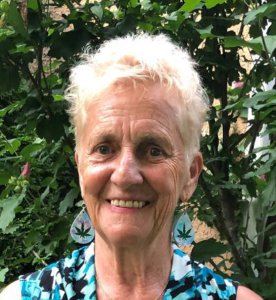 by Ann Allworth, Ph.D. and Cynthia Shelby-Lane, M.D.
by Ann Allworth, Ph.D. and Cynthia Shelby-Lane, M.D.
Members of NCIA’s Scientific Advisory Committee
There is abundant anecdotal evidence showing that people can live with cancer for decades after diagnosis. Several books and films describe various alternative approaches to traditional medicines that patients have used to help them heal, many citing the use of cannabis. For example “Weed the People” is an excellent film documenting the cannabis experiences of children with cancer and advocating for the sorely needed research on the healing potential of this powerful plant.
This blog will explain how cannabis can help our cells and the endocannabinoid system (ECS) components work together to weaken the ability of cancerous cells to survive. Let’s begin with a quick overview of cells and how they work. Cells are the smallest living unit in the body. There are about 200 different types of cells that come in different shapes and sizes, depending on their job. All cells are enclosed by a cell membrane which holds the cell’s contents and houses receptors, structures that allow cells to communicate with each other via ligands. Ligands carry specific messages and include, but are not limited to, neurotransmitters, hormones, growth factors, endocannabinoids, and phytocannabinoids. They circulate throughout the body in our bodily fluids and bind to specific receptors. Receptors have a binding site with a distinct shape that matches the shape of specific ligands. In other words, each ligand is like a key that fits a lock to “open” the receptor so that the message the ligand carries can be received and transmitted to the cell.
Receptors and ligands are two of the main components of the ECS. Even though it is called a system itself, the receptors and ligands of the ECS are found in other systems of the human body, such as the neurological, gastrointestinal, and immune systems. This means most cells in the body contain cannabinoid receptors, known as the first cannabinoid receptor, CB1, and the second cannabinoid receptor, CB2. These receptors are activated by cannabinoids our body makes itself, known as endocannabinoids [anandamide (AEA) and 2-arachidonoylglycerol (2-AG)], cannabinoids made by plants, known as phytocannabinoids, and some enzymes [e.g., fatty acid amide hydrolase (FAAH) and monoacylglycerol lipase (MAGL)].
This is an excellent basic understanding, but the ECS is much more complex. It is incredibly important to human health as its function is to maintain balance throughout the body and it helps to regulate many facets of physiological, behavioral, immunological, and metabolic functions in humans. The vast medicinal value of cannabis comes from the mixture of cannabinoids, terpenoids, and flavonoids that interact in some way with the ECS. Although research is still being performed to better explain how the ECS is involved with cancer, it has been demonstrated in animal and cell experiments that cannabis stops a number of vital functions in cancer cells, including proliferation, angiogenesis, and metastasis, and also causes apoptosis of malignant cancerous cells.
Proliferation is the scientific term for how quickly a cell can divide into two cells. Cancer cells can quickly proliferate because the molecules that regulate how often a cell can divide and create new cells have been disabled. This process allows cancer cells to grow in an uncontrolled fashion and to compete with healthy cells for space and nutrients. Animal and cell studies have shown that the compounds in cannabis can stop cancer cell proliferation in a wide variety of cancer types including breast, lung, prostate, liver, pancreatic, and many others.
Angiogenesis means the formation of new blood vessels. As cancer cells multiply and form large clumps, they secrete chemicals, many of which are ligands, that bind to receptors on cells in the tumor microenvironment. These cells receive the messages and begin building blood vessels. The newly formed blood vessels guarantee the growing clump of cancer cells will be fed all the nutrients and oxygen it needs to survive and flourish. A growing number of studies demonstrate that cannabis can inhibit angiogenesis in experimental cancer models.
Metastasis occurs when cancer cells spread to another part of the body other than where the cancer began. Cancer cells physically extend into the normal cells in their microenvironment, or they can pass through the walls of nearby blood or lymph vessels to get to distant locations. When they stop moving, they secrete messages that direct angiogenesis. Metastasis is a feature of more advanced cancer stages, such as stage 4 cancer. Experimental data shows that cannabis can hinder metastasis.
Apoptosis is a form of programmed cell death. Apoptosis is a process that cells perform if specific genes are turned on. The cell then goes through a series of steps that end in its death. Cannabis has been shown to induce apoptosis, which is an excellent fate for a cancer cell. Although the experimental data here is predominantly from animal and cell cancer models, it is likely that these critical cellular processes are happening when cancer patients improve using cannabis.
Hopefully soon, more research will help scientists elucidate the exact mechanisms by which patients experience relief using cannabis!
 Ann Allworth Ph.D. is founder and CEO of Cannabis Education Solutions. In her first year of undergrad, Ann Allworth Ph.D. developed a great interest in embryology while taking Anatomy & Physiology. After graduating, she enrolled in a Ph.D. program in cell biology and studied mammalian eggs and embryos. For several years after completing the program, she continued this research at Tufts University Health Sciences Center while working as a Gross Anatomy instructor. Next, Ann worked as an assistant professor at Howard University College of Medicine, continued teaching Gross Anatomy and began studying breast and ovarian cancer cells.
Ann Allworth Ph.D. is founder and CEO of Cannabis Education Solutions. In her first year of undergrad, Ann Allworth Ph.D. developed a great interest in embryology while taking Anatomy & Physiology. After graduating, she enrolled in a Ph.D. program in cell biology and studied mammalian eggs and embryos. For several years after completing the program, she continued this research at Tufts University Health Sciences Center while working as a Gross Anatomy instructor. Next, Ann worked as an assistant professor at Howard University College of Medicine, continued teaching Gross Anatomy and began studying breast and ovarian cancer cells.
After 19 years in medical academia, Ann did a 180 and moved on to the natural product industry, where she learned there were many alternatives to pharmaceuticals to achieving health. And among other topics, taught the immense value phytonutrient rich foods and herbs have to optimal health and well-being for almost 15 years. Upon learning of the existence of the endocannabinoid system (ECS) in March 2019 she was shocked she had never heard of it, but she is far from alone. The general public is for the most part clueless about the ECS and the medical establishment by and large ignores its existence. So, she decided to create a company dedicated to illuminating minds to the expansive nature of the ECS and its unparalleled importance to human health.
 Cynthia Shelby-Lane, MD, is an emergency physician, board-certified in anti-aging and functional medicine, and a certified Marijuana Doctor practicing medicine in Detroit, Michigan. Dr. Shelby-Lane has certified more than 10,000 medical cannabis patients in the State of Michigan. She coaches patients on their use of cannabis in conjunction with their current medications and medical conditions. She has been a member of NCIA and the Scientific Advisory Committee for the past five years, in addition to membership in multiple cannabis associations and organizations. She speaks at conferences/webinars and in the community on the use and benefits of cannabis and the evolving landscape of cannabis research. Dr. Shelby-lane has worked closely with the Last Prisoner Project.
Cynthia Shelby-Lane, MD, is an emergency physician, board-certified in anti-aging and functional medicine, and a certified Marijuana Doctor practicing medicine in Detroit, Michigan. Dr. Shelby-Lane has certified more than 10,000 medical cannabis patients in the State of Michigan. She coaches patients on their use of cannabis in conjunction with their current medications and medical conditions. She has been a member of NCIA and the Scientific Advisory Committee for the past five years, in addition to membership in multiple cannabis associations and organizations. She speaks at conferences/webinars and in the community on the use and benefits of cannabis and the evolving landscape of cannabis research. Dr. Shelby-lane has worked closely with the Last Prisoner Project.


Follow NCIA
Newsletter
Facebook
Twitter
LinkedIn
Instagram
–